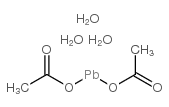Lead acetate reduces the ability of human umbilical cord mesenchymal stem cells to support hematopoiesis in vitro.
Xiaochun Sun, Yan Xie, Lele Wu, Wei Zhu, Jiabo Hu, Rongzhu Lu, Wenrong Xu
Index: Mol. Med. Report. 6(4) , 827-32, (2012)
Full Text: HTML
Abstract
Plumbum (Pb) is a heavy metal toxin that causes many pathophysiological effects in various systems of the human body. It has previously been reported that excessive lead trioxide causes hematopoietic system toxicity. Mesenchymal stem cells (MSCs), as cells with self-renewal and multipotent differentiation potential, play a supportive role in hematopoietic function. Lead is well known to interfere with hemoglobin synthesis and affect erythrocyte morphology and survival. MSCs and the cytokines secreted by MSCs are the important components of the hematopoietic microenvironment. Thus, we hypothesized that lead may cause damage to MSCs, which may provide a new understanding of the mechanism of lead toxicity in the hematopoietic system. In the present study, cell count, MTT assay, apoptosis assay, osteogenic differentiation, cell histochemical staining, cell cycle analysis, colony forming assay and RT-PCR were used. The results showed that the proliferation of umbilical cord MSCs (UCMSCs) was affected if the concentrations of lead were higher than 10 µM. Following osteogenic differentiation, the rate of alkaline phosphatase and Von Kossa stain positivity in the experimental group was lower than that in the control group. In conclusion, these results demonstrate that lead suppresses the self-renewal and multipotent differentiation potential of UCMSCs, and induces an adverse effect on the expression of UCMSCs cytokines. MSCs also have a hematopoiesis-promoting function that is capable of supporting colony formation of bone marrow cells. Furthermore, we found that following treatment with lead acetate, the supportive function of UCMSCs on colony formation was inhibited. Taken together, lead acetate has a toxic effect on the self-renewal, multipotent differentiation potential and hematopoiesis-promoting function of UCMSCs.
Related Compounds
| Structure | Name/CAS No. | Molecular Formula | Articles |
|---|---|---|---|
 |
lead diacetate trihydrate
CAS:6080-56-4 |
C4H12O7Pb |
|
Preventive efficacy of bulk and nanocurcumin against lead-in...
2013-04-01 [Biol. Trace Elem. Res. 152(1) , 31-40, (2013)] |
|
Plasmacatalytic removal of lead acetate assisted by precipit...
2014-07-01 [Chemosphere 107 , 304-10, (2014)] |
|
Nephroprotective effect of calcium channel blockers against ...
2013-04-26 [Toxicol. Lett. 218(3) , 273-80, (2013)] |
|
Lactobacillus plantarum CCFM8661 alleviates lead toxicity in...
2012-12-01 [Biol. Trace Elem. Res. 150(1-3) , 264-71, (2012)] |
|
Involvement of CTR1 and ATP7A in lead (Pb)-induced copper (C...
2014-02-10 [Toxicol. Lett. 225(1) , 110-8, (2014)] |